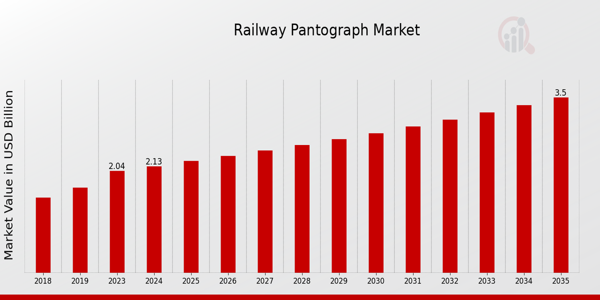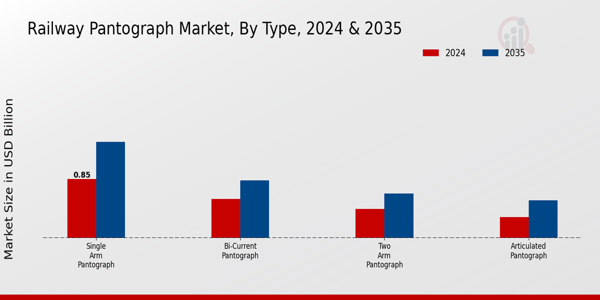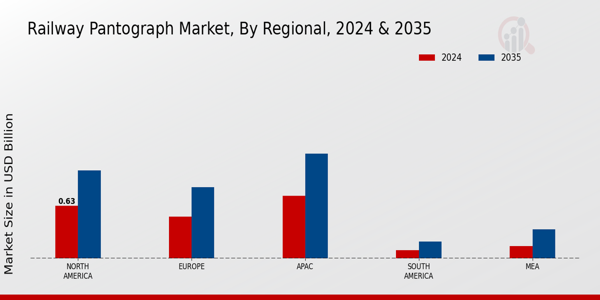Global Railway Pantograph Market Overview :
As per MRFR analysis, the Railway Pantograph Market Size was estimated at 2.04 (USD Billion) in 2023. The Railway Pantograph Market Industry is expected to grow from 2.13 (USD Billion) in 2024 to 3.5 (USD Billion) by 2035. The Railway Pantograph Market CAGR (growth rate) is expected to be around 4.62% during the forecast period (2025 - 2035).
Key Railway Pantograph Market Trends Highlighted
The Global Railway systems are intertwined with several key drivers that are shaping its growth trajectory. The never ending desire and need for dependable and efficient railway systems mandates operators to enhance the current infrastructure and put money in newer and advanced technologies for pantographs. The governments are also embarking on sustainable transport solutions, which results in the growth of electrified rail networks that heavily depend on pantographs for energy. In addition, the focus on carbon emission reduction is encouraging manufacturers to innovate and engineer energy-efficient pantograph systems that are operationally useful and also meet the environmental standards. With the progress of smart technologies, so much has become possible in the market. the opportunities in the market are virtually endless.
The introduction of IoT and automation in rail systems could be leveraged to enhance the multifunction modular monitoring and performance of the pantographs, thus increasing safety and operational efficiency. Moreover, as urban areas continue to develop, the need for urban transit systems increases, thus giving pantograph manufacturers a chance to service metropolitan railway networks. Developing areas that are modernizing and reconstructing their railway infrastructure can also expand their regions. Recent trends in the market seem to be shifting to lightweight materials and other more efficiency focused designs that do not compromise on durability.
Manufacturers have shifted their focus towards R&D with the aim of developing more advanced and durable pantographs that are resilient to fluctuating environmental conditions. There is a noticeable willingness among companies to cooperate in developing pantograph technology, thus adding to the level of competition in the industry. The idea of predictive maintenance is becoming more popular and enables rail operators to improve systens utilization and reduce the idle time, which in turn suggests a more active stance towards the management of pantograph assets. In general, the changes within the scope of the Railway Pantograph Market are a reaction to new technologies and changing market conditions and requirements.

Source: Primary Research, Secondary Research, MRFR Database and Analyst Review
Railway Pantograph Market Drivers
Growing Urbanization and Public Transportation Needs
The rapid pace of urbanization across the globe is substantially driving the demand for efficient public transportation systems. As cities expand, the need for sustainable and reliable mass transit options becomes increasingly critical. Railway systems serve as pivotal components in the framework of urban infrastructure, facilitating the movement of large populations efficiently. As urban centers become more congested, the Railway Pantograph Market Industry sees a significant upsurge in demand for advanced pantograph systems that can support electric trains and trams. This shift towards electrification of rail networks aligns with environmental policies aimed at reducing carbon footprints and enhancing air quality, creating a clear trajectory for market growth.
Additionally, governments and private sectors are increasingly investing in modernizing railway infrastructure to accommodate this increasing demand for rapid transit solutions. The updated rail systems not only improve connectivity within cities but also promote regional economic development, presenting numerous opportunities for growth. With advancements in technology and an increasing preference for electric trains due to their efficiency, the market for railway pantographs is set to flourish. Emerging markets are also beginning to see similar patterns of urban growth and increasing investment in public transportation, further reinforcing the demand for railway pantographs. This ongoing trend is likely to play a crucial role in shaping the future landscape of the railway pantograph market.
Technological Advancements in Railway Systems
Innovation in technology is a key driver for the Railway Pantograph Market Industry, leading to enhanced performance and efficiency of railway systems. The development of smart pantograph systems equipped with advanced materials and intelligent features is changing the way rail networks operate. Innovations such as automated monitoring and maintenance solutions contribute to reducing operational costs and improving safety standards. These technological advancements enable operators to optimize energy consumption, further boosting the appeal of modern electric rail systems. The increasing trend toward integrating digital solutions into railway operations is expected to be a major factor driving market growth.
Government Investments in Rail Infrastructure
The significant focus of governments on enhancing rail infrastructure to promote economic growth significantly impacts the Railway Pantograph Market Industry. Public investments in upgrading aging rail systems and expanding networks create substantial opportunities for pantograph manufacturers. Initiatives aimed at boosting regional connectivity through improved rail services highlight the importance of investing in reliable and efficient railway technologies. This continuous governmental focus on rail infrastructure development positions the railway pantograph market for sustained growth in the forthcoming years.
Railway Pantograph Market Segment Insights:
Railway Pantograph Market Type Insights
The Railway Pantograph Market is projected to be valued at 2.13 billion USD in 2024 and is expected to see an overall growth reaching 3.5 billion USD by 2035, emphasizing the increasing demand for efficient rail solutions. Within this market, the Types of railway pantographs play a crucial role in power collection from overhead wires for electric trains. The Single Arm Pantograph holds a majority portion of the market, valued at 0.85 billion USD in 2024 and anticipated to rise to 1.39 billion USD by 2035. This significant share showcases its effectiveness in reducing drag and enhancing aerodynamic performance, making it a choice for many modern rail systems.
Following it, the Bi-Current Pantograph is valued at 0.56 billion USD in 2024, with a future projection of 0.83 billion USD by 2035. This type is important as it enables trains to operate across different power systems, catering to areas with varying electrification standards, thereby allowing greater operational flexibility. The Two Arm Pantograph, while smaller in size, holds a market value of 0.42 billion USD in 2024 and is expected to reach 0.64 billion USD by 2035. Its design provides stability during high-speed operations, making it a preferred option for express and high-speed trains. Lastly, the Articulated Pantograph is valued at 0.3 billion USD in 2024, with a projected increase to 0.54 billion USD by 2035.
Although it represents the smallest share within the market, its design is specifically tailored to reduce wear on overhead lines and improve energy efficiency, which adds value in specific areas of rail transportation. Overall, the market segmentation reveals a distinct hierarchy, where the Single Arm Pantograph significantly dominates the landscape, while the Bi-Current and Two Arm options provide essential functionalities for modern and high-speed rail applications. Each type is tailored for specific operational efficiencies and demands, which collectively contribute to the global railway pantograph landscape, making ongoing innovation and investments in this market not just vital, but a key driver of sustainable transportation solutions as seen through current Railway Pantograph Market statistics.

Source: Primary Research, Secondary Research, MRFR Database and Analyst Review
Railway Pantograph Market Material Insights
The Railway Pantograph Market, valued at 2.13 billion USD in 2024, reflects a comprehensive segmentation by Material, which includes key components such as Copper, Aluminum, Carbon Composite, and Steel. Each material plays a crucial role in the efficiency and reliability of pantographs, which are integral for electrical transmission in trains. Copper has traditionally dominated due to its excellent conductivity, making it essential for optimal performance. Aluminum is gaining traction for its lightweight properties and corrosion resistance, which enhances energy efficiency and component lifespan.
Carbon composite materials are emerging, offering significant advantages in weight reduction and strength, while Steel remains a significant choice for structural integrity in various applications. This diversified use of materials contributes substantially to the overall Railway Pantograph Market revenue and is integral to meeting the increasing demands for sustainable and efficient rail systems. Market growth is driven by the ongoing investments in railway infrastructure and advancements in railway technology, though companies must navigate challenges such as material costs and supply chain constraints to fully capitalize on available opportunities in this evolving landscape.
Railway Pantograph Market Application Insights
The Railway Pantograph Market is expected to be valued at 2.13 USD Billion in 2024, showcasing robust growth opportunities within the Application segment. This segment includes Passenger Trains, Freight Trains, Trams, and Metro Systems, each playing a crucial role in urban and intercity transportation networks. Passenger Trains are significant, driven by increasing urbanization and demand for efficient public transportation solutions. Freight Trains also dominate due to rising global trade and the need for reliable cargo transport.
Meanwhile, Trams contribute to eco-friendly urban mobility solutions, while Metro Systems are essential for managing high passenger volumes in cities. The evolution of infrastructure and advancements in technology are key growth drivers, while challenges such as maintenance costs and the need for timely upgrades may impact market dynamics. Overall, the robust demand for efficient and sustainable transportation solutions propels the Railway Pantograph Market revenue, creating numerous opportunities across these applications.
Railway Pantograph Market Contact System Insights
The Contact System segment of the Railway Pantograph Market plays a crucial role in facilitating efficient energy transmission for electric trains. By 2024, this market is expected to be valued at 2.13 USD Billion, reflecting the growing reliance on rail transport as a sustainable option. Within this segment, the Overhead Line System emerges as a dominant player, widely adopted for its ability to deliver a stable power supply over long distances, making it essential for high-speed rail networks. In contrast, the Third Rail System is significant in urban transit systems, where space constraints and cost-efficiency are critical factors.
The Railway Pantograph Market data reveals that these systems are pivotal in supporting the increased demand for electrification in railway networks, driven by environmental concerns and the need for operational efficiency. Market trends indicate a continued investment in these systems, thereby enhancing their importance as the railway industry evolves. However, challenges such as infrastructure costs and maintenance requirements necessitate ongoing innovation. Overall, this segment represents a fundamental aspect of the railway pantograph market, reflecting the broader trends and dynamics influencing the industry.
Railway Pantograph Market Regional Insights
The Regional segment of the Railway Pantograph Market is poised for steady growth. In 2024, the North America market generates $0.63 Billion, expected to increase to $1.05 Billion by 2035, demonstrating its significant share and dominance due to extensive railway networks and modernization efforts. Europe is valued at $0.5 Billion in 2024, projected to reach $0.85 Billion by 2035, reflecting a steady demand driven by sustainable transportation initiatives. The APAC region, valued at $0.75 Billion initially, is set to grow to $1.25 Billion, making it a major player due to rapid urbanization and infrastructure development.
In contrast, South America starts at $0.1 Billion, with growth to $0.2 Billion, indicating less dominance but potential as rail transport improves. The MEA region follows with $0.15 Billion in 2024, reaching $0.35 Billion by 2035, representing a gradually expanding market influenced by investments in rail infrastructure. The insights from the Railway Pantograph Market revenue highlight significant opportunities in each region, shaped by unique growth of drivers and challenges in the implementation of advanced rail technologies.

Source: Primary Research, Secondary Research, MRFR Database and Analyst Review
Railway Pantograph Market Key Players and Competitive Insights :
The Railway Pantograph Market has seen various competitive dynamics shaped by technological advancements, evolving regulations, and the increasing emphasis on sustainable transportation solutions. As rail networks expand worldwide to accommodate growing passenger and freight demands, manufacturers in this market are actively enhancing their product offerings to stay ahead of the curve. Companies are focusing on innovation, quality, and performance improvements to meet the requirements of modern rail systems. Factors such as the integration of smart technologies into pantograph systems, coupled with a strong emphasis on ensuring operational reliability, have emerged as key competitive strategies. These trends highlight the need for continuous investment in research and development to produce high-quality pantographs that cater to diverse operational needs across varying environments.
KnorrBremse has established a formidable presence in the Railway Pantograph Market, distinguishing itself through a strong reputation for safety, quality, and innovation. The company’s extensive experience in rail systems and braking solutions empowers it to deliver advanced pantograph products that enhance operational efficiency. Notably, KnorrBremse focuses on developing pantographs that not only ensure reliable contact with overhead lines but also integrate seamlessly with modern rail technology, thereby improving overall train performance. The company fosters strategic partnerships and collaborations that further bolster its market position, enabling quick adaptation to emerging trends and regulatory demands. Its commitment to sustainability is evident in product design, which minimizes energy losses and contributes to reducing the carbon footprint of rail operations.
Mitsubishi Electric holds a significant role in the Railway Pantograph Market by leveraging its technological expertise and strong brand recognition. The company’s pantographs are known for their high-quality manufacturing and innovative features designed to enhance reliability and stability during train operation. Mitsubishi Electric invests heavily in advanced manufacturing processes and research initiatives to ensure that its pantograph solutions comply with the latest industry standards and safety regulations. The company placed strong emphasis on minimizing maintenance requirements and extending the operational lifespan of its products, giving it a competitive edge. Furthermore, Mitsubishi Electric’s global reach allows it to cater to various markets effectively while maintaining a focus on delivering solutions that meet the unique requirements of different rail systems around the world.
Key Companies in the Railway Pantograph Market Include:
- KnorrBremse
- Mitsubishi Electric
- LRV
- Wabtec
- CAF
- Bombardier
- ABB
- Ruggedcom
- Alstom
- CRRC Corporation
- Hitachi
- Schneider Electric
- Stadler
- Siemens
- Voith
Railway Pantograph Market Industry Developments
Recent developments in the Railway Pantograph Market reflect a significant focus on technological advancements and sustainability. Companies like Knorr-Bremse and Mitsubishi Electric are investing in innovative pantograph systems that enhance energy efficiency and reduce maintenance costs. The market is witnessing an ongoing trend towards electrification in rail systems, leading to increased demand for high-performance pantographs that can support modern electric trains. Additionally, Wabtec and Alstom have introduced new lightweight materials and designs aimed at improving aerodynamic performance.
In the realm of mergers and acquisitions, Wabtec's acquisition of GE Transportation has strengthened its capabilities in rail technology and pantograph systems. Meanwhile, ABB is expanding its portfolio through collaborations with companies like Stadler to integrate smart technology into their pantograph products. The market valuation is also on the rise, with substantial growth driven by the adoption of high-speed rail systems, backed by government investments in infrastructure projects across various countries. Companies are adapting to this growth by enhancing production capacities and investing in research and development, indicating a robust future for the Railway Pantograph Market.
Railway Pantograph Market Segmentation Insights
Railway Pantograph Market Type Outlook
- Single Arm Pantograph
- Bi-Current Pantograph
- Two Arm Pantograph
- Articulated Pantograph
Railway Pantograph Market Material Outlook
- Copper
- Aluminum
- Carbon Composite
- Steel
Railway Pantograph Market Application Outlook
- Passenger Trains
- Freight Trains
- Trams
- Metro Systems
Railway Pantograph Market Contact System Outlook
- Overhead Line System
- Third Rail System
Railway Pantograph Market Regional Outlook
- North America
- Europe
- South America
- Asia Pacific
- Middle East and Africa
| Report Attribute/Metric Source: |
Details |
| MARKET SIZE 2023 |
2.04 (USD Billion) |
| MARKET SIZE 2024 |
2.13 (USD Billion) |
| MARKET SIZE 2035 |
3.5 (USD Billion) |
| COMPOUND ANNUAL GROWTH RATE (CAGR) |
4.62% (2025 - 2035) |
| REPORT COVERAGE |
Revenue Forecast, Competitive Landscape, Growth Factors, and Trends |
| BASE YEAR |
2024 |
| MARKET FORECAST PERIOD |
2025 - 2035 |
| HISTORICAL DATA |
2019 - 2024 |
| MARKET FORECAST UNITS |
USD Billion |
| KEY COMPANIES PROFILED |
KnorrBremse, Mitsubishi Electric, LRV, Wabtec, CAF, Bombardier, ABB, Ruggedcom, Alstom, CRRC Corporation, Hitachi, Schneider Electric, Stadler, Siemens, Voith |
| SEGMENTS COVERED |
Type, Material, Application, Contact System, Regional |
| KEY MARKET OPPORTUNITIES |
Increasing electrification of rail networks, Growing focus on sustainable transport, Demand for advanced automation technology, Expansion of high-speed rail projects, Rising investments in rail infrastructure |
| KEY MARKET DYNAMICS |
Technological advancements, Increasing electrification initiatives, Rising demand for high-speed trains, Maintenance and replacement needs, Government investments in infrastructure |
| COUNTRIES COVERED |
North America, Europe, APAC, South America, MEA |
Frequently Asked Questions (FAQ) :
The Railway Pantograph Market is expected to be valued at 2.13 USD billion in 2024.
By 2035, the Railway Pantograph Market is anticipated to reach a valuation of 3.5 USD billion.
The expected CAGR for the Railway Pantograph Market from 2025 to 2035 is 4.62%.
In 2024, North America is projected to hold the largest market share with a valuation of 0.63 USD billion.
The APAC region is expected to grow to a market size of 1.25 USD billion by 2035.
Key competitors in the Railway Pantograph Market include companies like KnorrBremse, Mitsubishi Electric, and Alstom.
The expected market size for the Single Arm Pantograph is projected to be 1.39 USD billion in 2035.
Potential challenges affecting the growth of the Railway Pantograph Market include technological advancements and regulatory frameworks.
The growth in the Railway Pantograph Market is driven by applications in urban transit and freight rail systems.
The Bi-Current Pantograph is expected to reach a market size of 0.83 USD billion by 2035.

















